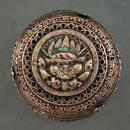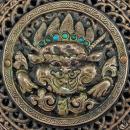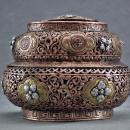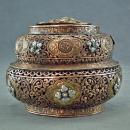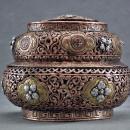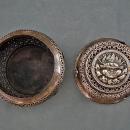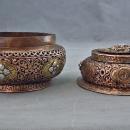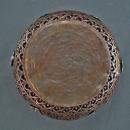Antique 18th century Tibetan Buddhist incense Box With Kirtimukha








$1,000.00
Antique 18th century Tibetan Buddhist ritual incense Burner - Censer of oval bulbous form, made of superbly hand hammered copper, finely embossed, chiseled, pierced with various designs, and jeweled with natural rubies and turquoise stones.
The top of the lid is adorned with a separately made medallion riveted to the cover, depicting the wrathful Tibetan Buddhist guardian deity, Kirtimukha, which translates from Sanskrit as "face of glory," or Chibar in Tibetan, which means "that which resembles nothing."
It is considered to be a symbol of protection.
The face is hand repoussé and sculptured in relief with great precision and crispness of its chiseling, with eyes inset with natural ruby gemstone cabochons.
Kirtimukh's extravagant crown is jeweled with 7 round natural turquoise.
The sides of the cover are finely hand repoussé, chiseled and pierced with scrolled lotus designs and 6 lobed medallions comprising long-life "Shu" symbols. Between are riveted to the lid 4 silver vishvavajra or "crossed vajra," finely hand repoussé and chiseled, and set with natural turquoises ( 2 vishvavajra are missing). All adorned with roped silver bands.
The bowl is similarly decorated on the top, hand repoussé, chiseled and pierced with scrolled lotus designs and 6 lobed medallions highlighted in gold and set with 6 silver vishvavajra or "crossed vajra," also finely hand repousséd and chiseled.
The foot rim is engraved with a Meander key pattern matching the pattern on the lid.
Kīrtimukha (कीर्तिमुख) literally means "face of glory," it is an all-devouring monster that is used across Asia as an auspicious decorative element that is supposed to consume evil.
The origins of the design are murky and go back at least 2 millennia. One myth of origin comes from the Hindu Skanda Purana of India of the 8th century B.C. It was described as spawning from Shiva's third eye in a burst of rage. It was meant to devour the terrible beat Rahu, but upon seeing Kīrtimukha, Rahu surrendered and was offered protection by Shiva.
This left Kīrtimukha's without something to devour, and Shiva suggested it should devour itself, which it did until only its face and upper jaw remained. Shiva then ordered it to be used as an ornament above temple doors and exclaimed that no one would obtain Shiva's grace without worshipping Kīrtimukha. It since become an auspicious ornament with evil devouring properties.
In China, a remarkably similar motif appears even earlier on bronze vessels of the Shang dynasty of the 16th to 10th century B.C. Its first written description is in the Zuo Zhuan of the 4th century B.C., where it was called tāotiè (饕餮), literally meaning "gluttonous." In China, too, it customarily appears without its lower jaw, which is one of its main distinguishing features.
CONDITION: showing age and use, with an old patina, one of the, silver vajra is broken off, and 2 vishvavajra on the cover are missing. No cracks or repairs.
MEASUREMENTS:
Diameter: 16 cm (6.3 inches).
Height: 12.5 cm (4.92 inches).
